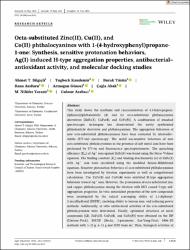| dc.contributor.author | Bilgiçli, Ahmet T. | |
| dc.contributor.author | Kandemir, Tugberk | |
| dc.contributor.author | Arıduru, Rana | |
| dc.contributor.author | Günsel, Armagan | |
| dc.contributor.author | Abak, Çagla | |
| dc.contributor.author | Yarasir, M. Nilüfer | |
| dc.contributor.author | Arabaci, Gulnur | |
| dc.date.accessioned | 2022-05-13T09:01:36Z | |
| dc.date.available | 2022-05-13T09:01:36Z | |
| dc.date.issued | 18 June 2021 | tr |
| dc.identifier.citation | 1Department of Chemistry, Sakarya University, Sakarya, Turkey
2Department of Chemistry, Cumhuriyet University, Sivas, Turkey | tr |
| dc.identifier.uri | https://hdl.handle.net/20.500.12418/13005 | |
| dc.description.abstract | This study shows the synthesis and characterization of 4,5-bis(4-propionylphenoxy)
phthalonitrile (2) and its octa-substituted phthalocyanine
derivatives [ZnPc(3), CuPc(4), and CoPc(5)]. A combination of standard
spectroscopic techniques has characterized the newly synthesized
phthalonitrile derivative and phthalocyanines. The aggregation behaviors of
new octa-substituted phthalocyanines have been evaluated by ultraviolet–
visible (UV-vis) spectroscopy. The metal ion-sensitive behaviors of new
octa-substituted phthalocyanines in the presence of soft metal ions have been
performed by UV-vis and fluorescence spectrophotometer. The quenching
efficiency (Ksv) of Ag+ ions against ZnPc(3) was found using the Stern–Volmer
equation. The binding constant (Ka) and binding stoichiometry (n) of ZnPc(3)
with Ag+ ions were calculated using the modified Benesi–Hildebrand
equation. Sensitive protonation behaviors of octa-substituted phthalocyanines
have been investigated by titration experiments as well as computational
calculations. The ZnPc(3) and CuPc(4) were exhibited H-type aggregation
behaviors toward Ag+ ions. However, the protonation of octa-substituted zinc
and copper phthalocyanine during the titration with HCl caused J-type selfaggregation
properties. In vitro antioxidant properties of the new compounds
were investigated by the radical scavenging ability of 1,1-diphenyl-
2-picrylhydrazyl (DPPH), chelating ability to ferrous ions, and reducing power
methods. Additionally, in vitro antibacterial activities of the octa-substituted
phthalocyanines were determined. Finally, optimized structures of novel
compounds [(2), ZnPc(3), CuPc(4), and CoPc(5)] were obtained on the HF
(Hartree–Fock), B3LYP (Becke, 3-parameter, Lee-Yang-Parr), M06–2X
methods with 3–21 g, 6–31 g and SDD basis set. Then, biological activities of novel phthalonitrile and its phthalocyanine derivatives toward breast, liver,
and lung cancer proteins were compared with molecular docking studies. | tr |
| dc.language.iso | eng | tr |
| dc.relation.isversionof | https://doi.org/10.1002/aoc.6353 | tr |
| dc.rights | info:eu-repo/semantics/openAccess | tr |
| dc.subject | antimicrobial and antioxidant | tr |
| dc.subject | H- or J-type aggregation | tr |
| dc.subject | molecular docking | tr |
| dc.subject | phthalocyanine | tr |
| dc.subject | protonation | tr |
| dc.title | Octa-substituted Zinc(II), Cu(II), and Co(II) phthalocyanines with 1-(4-hydroxyphenyl)propane- 1-one: Synthesis, sensitive protonation behaviors, Ag(I) induced H-type aggregation properties, antibacterial– antioxidant activity, and molecular docking studies | tr |
| dc.type | article | tr |
| dc.contributor.department | Sivas Meslek Yüksekokulu | tr |
| dc.identifier.volume | 35 | tr |
| dc.identifier.startpage | e6353 | tr |
| dc.relation.publicationcategory | Uluslararası Editör Denetimli Dergide Makale | tr |















